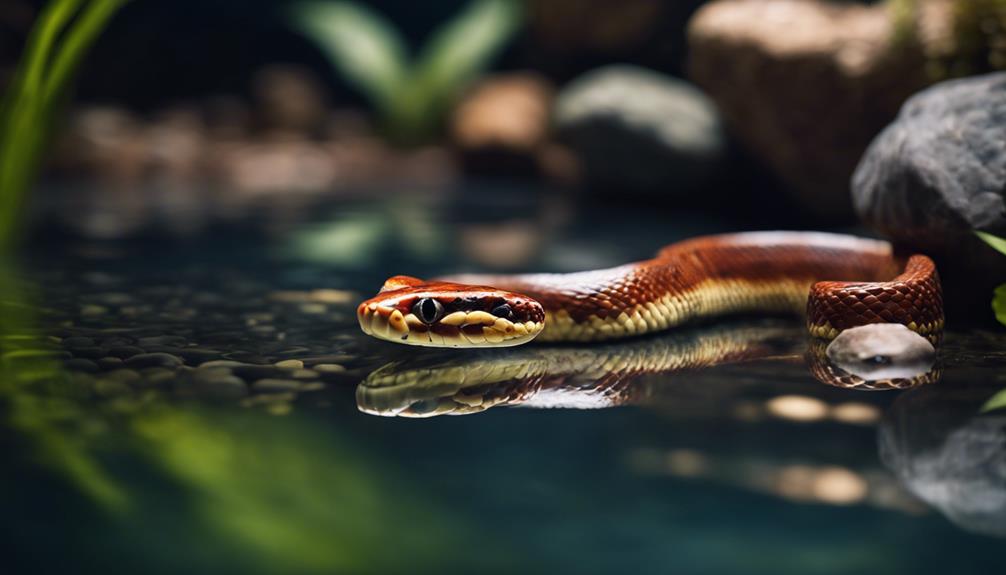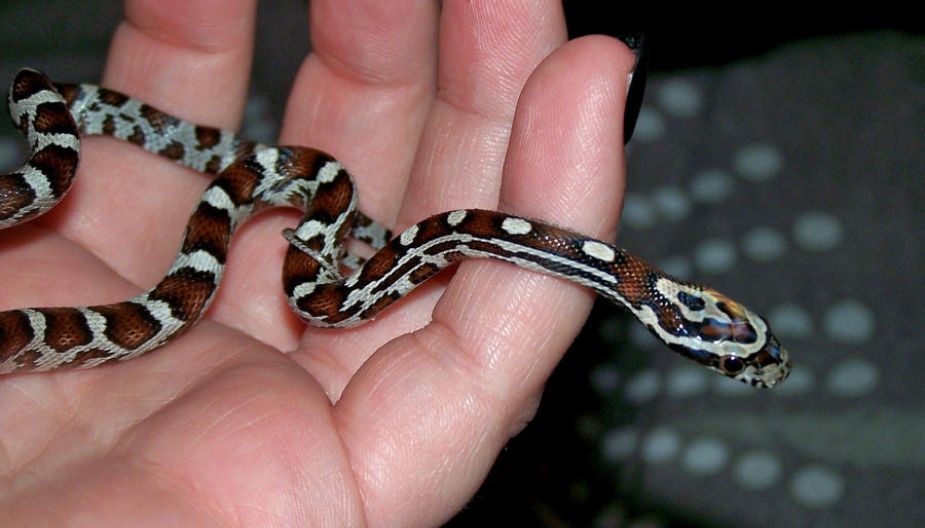Ensuring the safety and well-being of your corn snake involves teaching them how to swim safely.
Grasping the correct methods and safety measures can greatly influence your reptile's overall health and happiness.
By applying the appropriate strategies and curating a fitting environment, the quality of life of your corn snake can be improved.
Key Takeaways
- Monitor water temperature closely to keep it between 80-85°F for the snake's comfort and well-being.
- Gradually introduce the snake to water, starting with a small bowl and increasing depth slowly.
- Supervise swimming sessions to prevent accidents, monitor breathing patterns, and ensure the snake's safety.
- Maintain a clean water environment, change water regularly, and use a shallow bowl with rounded edges to prevent injuries.
Safety Precautions for Swimming Corn Snakes
To guarantee the safety of your corn snake during swimming sessions, continuous supervision is essential to prevent any potential accidents or exhaustion. Snakes, while not natural swimmers, can enjoy a swim if provided with the right conditions.
When allowing your corn snake to swim, make sure the water temperature is maintained between 80-85°F, as colder temperatures can lead to stress and potential health issues. Introduce your snake gradually to deeper sections of water in their enclosure to help them acclimate and feel secure.
While bathing your snake, be attentive to signs of distress or fatigue, and never leave them unattended in the water. After swimming, it's important to thoroughly dry your corn snake before returning them to their enclosure to prevent any respiratory problems.
Prioritizing these safety measures will contribute to a safe and enjoyable swimming experience for your corn snake.
Choosing the Right Water Environment
Choosing an appropriate water environment for teaching corn snakes to swim involves ensuring cleanliness and freedom from contaminants. When setting up the bathing area for your corn snake, opt for a shallow bowl with rounded edges to prevent any injuries while they swim around. It is crucial to maintain the water temperature between 80-85°F, as this range mimics their body temperature and provides a comfortable experience. Use lukewarm water to fill the bathing bowl, ensuring it is clean and free from any chemicals or impurities that could harm your pet. Monitoring your corn snake closely during their swimming sessions is essential to ensure they are safe and comfortable throughout the process. By gradually introducing them to the water environment and paying attention to their behavior, you can help your corn snake learn to swim safely and enjoyably.
| Aspect | Description |
|---|---|
| Water Temperature | Maintain between 80-85°F to mimic corn snake's body temperature for a comfortable experience. |
| Container Type | Choose a shallow bowl with rounded edges to prevent injuries during swimming lessons. |
| Water Cleanliness | Ensure the water is clean and free from contaminants to safeguard your corn snake's health. |
| Monitoring | Keep a close eye on your corn snake during swimming sessions to ensure their safety. |
Introduction to Water for Corn Snakes
Introducing corn snakes to water involves gradually acclimating them to a shallow water bowl in their enclosure to help them become comfortable with swimming. Corn snakes have a natural ability to swim, making it important to provide access to a water source within their enclosure. The water in the bowl should be vital, at a comfortably warm temperature, and have enough depth for the snake to submerge its body. This mimics their natural habitat where they may encounter water for drinking, bathing, or regulating body temperature.
Ensuring the water is changed regularly is essential to maintain cleanliness and prevent bacterial growth. Corn snakes may also use the water bowl to help with shedding, so having a suitable size bowl that allows the snake to comfortably soak is necessary. By introducing water gradually and monitoring the snake's behavior, you can help them adjust to swimming safely within their enclosure. This initial exposure sets the foundation for their comfort and well-being when it comes to water activities.
Gradual Introduction to Swimming
When acclimating corn snakes to swimming, gradually introduce a shallow water bowl in their enclosure to familiarize them with water. Slowly increasing the water depth over time will allow the corn snake to become comfortable with swimming.
It's important to make sure the water temperature is maintained between 80-85°F as this range is suitable for the snake's well-being.
Here are some essential steps for a gradual introduction to swimming:
- Provide a small bowl: Start with a small water bowl to begin the process gently.
- Warm water: Make certain the water is comfortably warm for the corn snake.
- Enough space: Offer sufficient space for the snake to move around and explore the water.
- Monitor closely: Keep a close eye on the snake during the introduction to swimming to guarantee a safe environment.
Monitoring Corn Snake's Swimming Behavior
To effectively monitor a corn snake's swimming behavior, carefully observe its body movements, swimming style, and breathing patterns for signs of importance and guarantee. When the snake is in water, pay attention to how it propels itself forward, making sure it moves smoothly and without excessive struggling. A comfortable snake will exhibit fluid movements and may even explore its aquatic environment with curiosity. As you supervise the swimming session, monitor the snake's breathing to make sure it remains steady and regular. Any signs of respiratory distress, such as wheezing or gasping for air, should be promptly addressed by removing the snake from the water.
Maintaining the water temperature within the recommended range of 80-85°F is vital for the snake's well-being during swimming sessions. Sudden temperature fluctuations can cause stress and discomfort, leading to potential health issues. Watch for any signs of distress, such as rapid movements or attempts to escape the water, as these could indicate that the snake isn't enjoying the swimming experience. By closely observing and supervising your corn snake's swimming behavior, you can guarantee a safe and enjoyable aquatic activity for your pet.
Frequently Asked Questions
Can I Put My Corn Snake in Water?
You can put your corn snake in water. Guarantee snake behavior and water safety by supervising. Use swimming techniques, proper tank setup, handling precautions, and aquatic enrichment for health benefits. Maintain temperature regulation and watch for behavioral cues.
Why Do Corn Snakes Soak in Water?
Water temperature and shedding benefits are reasons corn snakes soak. Skin hydration, natural behavior, and habitat enrichment are crucial. Soaking guarantees health, encourages movement, and offers safety. Remember handling techniques and fun activities for a happy snake.
How Do You Get a Corn Snake to Trust You?
To get a corn snake to trust you, spend time daily near its enclosure, handle gently for consistent trust building, avoid sudden movements, offer food from tongs for positive association, be patient, let the snake approach you.
How Do You Tame a Corn Snake?
To tame a corn snake, handle gently, offer food by hand, and introduce to water gradually. Watch for behavioral cues, use positive reinforcement, and build trust through socialization. Use desensitization steps, communication signals, and bonding exercises for confidence building.
Conclusion
To sum up, teaching corn snakes to swim safely requires careful consideration of their well-being and comfort. By following proper safety precautions and gradually introducing them to water environments, you can guarantee a positive swimming experience for your pet.
Just as water symbolizes life and renewal, swimming can be a beneficial activity for corn snakes, promoting their overall health and vitality. Remember to always monitor their behavior and provide a suitable environment for them to thrive in.


